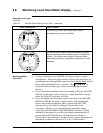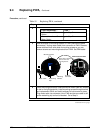
6/08 ST 3000 Release 300 and SFC Model STS103 User’s Manual 171
9.3 Inspecting and Cleaning Barrier Diaphragms
Background
Depending on the characteristics of the process medium being
measured, sediment or other foreign particles may collect in the process
head cavity/chamber and cause faulty measurement. In addition, the
barrier diaphragm or diaphragms in the transmitter’s meter body may
become coated with a residue from the process medium. The latter is
also true for external diaphragms on flange mount and remote seal type
transmitters.
In most cases, you can readily remove the process head or heads from
the transmitter’s meter body to clean the process head cavity and inspect
the barrier diaphragm or diaphragms. For flange mount and remote seal
diaphragms, you may only need to run a purge line in the tank to rinse
off the face of the diaphragm.
Procedure
The procedure in Table 53 outlines the general steps for inspecting and
cleaning barrier diaphragms. You may have to modify the steps to meet
your particular process or transmitter model requirements.
Table 53 Inspecting and Cleaning Barrier Diaphragms
Step Action
1
Close all valves and isolate transmitter from process. Open vent in
process head to drain fluid from transmitter’s meter body, if required.
ATTENTION
We recommend that you remove the transmitter
from service and move it to a clean area before taking it apart.
2
Remove nuts from bolts that hold process head or heads to meter
body. Remove process heads and bolts.
Nuts
Process
head
O-ring
Center
section
Process
head
O-ring
Bolts
Continued on next page


















